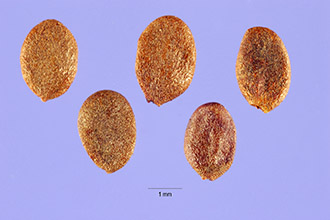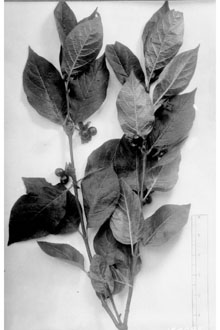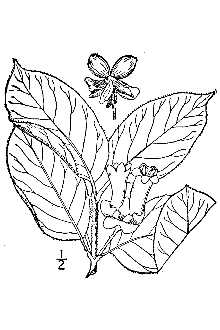Twinberry Honeysuckle
Scientific Name: Lonicera involucrata (Richardson) Banks ex Spreng.

| General Information | |
|---|---|
| Usda Symbol | LOIN5 |
| Group | Dicot |
| Life Cycle | Perennial |
| Growth Habits | Shrub |
| Native Locations | LOIN5 |
Plant Guide
Alternative Names
twinberry, black twin-berry, four-line honeysuckle, bearberry honeysuckle
Uses
Warning: Twinberry honeysuckle is considered toxic and should be used with caution. Ethnobotanic: The Quileute and Kwakwaka’wakw people used these berries as a black pigment (Pojar & MacKinnon 1994). The Haida rubbed the berries on the scalp to prevent hair from turning gray (Ibid.). A decoction of the bark has been applied to a woman’s breasts to encourage milk flow (Moerman 1998). An infusion was used to treat chest and stomach complaints and to cleanse the body (Ibid.). The Carrier boiled the leaves and used the liquid to bathe sore eyes, or applied the crushed leaves as a poultice to open sores (Pojar & MacKinnon 1994).
Status
Please consult the Plants Web site and your State Department of Natural Resources for this plant’s current status, such as, state noxious status and wetland indicator values.
Description
General: Honeysuckle family (Caprifoliaceae). Twinberry honeysuckle (Lonicera involucrata) is an erect clustered shrub one to three meters high with freely exfoliating bark (Peck 1961). The leaves are opposite, short-stemmed, somewhat elliptical to broadly lanced shaped, pointed often hairy beneath (Pojar & MacKinnon 1994). The flowers are yellow, tinged with red, and cupped by a large pair of green to purplish bracts. The fruits are roundish or oval, blackish berries, paired on long axillary stalks and distinct; ripening August or September (Grimm 1993). Alfred Brousseau © Saint Mary's College of California @CalPhotos Distribution: Lonicera involcrata is widely distributed across North America from Quebec westward to Alaska and British Columbia and southward into California, Colorado, Utah, and Arizona (McMinn 1939). For current distribution, please consult the Plant profile page for this species on the PLANTS Web site.
Adaptation
Twinberry honeysuckle is typically found in moist forests, clearings, riparian habitats, swamps and thickets (MacKinnon, Pojar & Coupe′ 1992). It prefers a good moist soil but can succeed in any fertile soil. This species grows best and produces abundance of fruit in open sunlight compared to a lost of fruit when grown in the shade.
Establishment
Propagation by Seed: Lonicera involucrata seeds should be collected from isolated plants and extracted by maceration in water (Dirr & Heuser 1987). Sow the seeds as soon as they are ripe in a cold frame. When the seedlings are large enough, plant them directly into their permanent positions in late spring or early summer.
Management
Twinberry honeysuckle berries has been noted as poisonous, Use soil moisture sensors to measure the soil moisture of Twinberry Honeysuckle., The fruit is bitter and sour and are eaten by some, Since the European species of honeysuckle species are regarded as emetic and cathartic, they are better avoided in favor of something less dubious (Mozingo 1987), Cultivars, Improved and Selected Materials (and area of origin) Somewhat available from native plant nurseries, Contact your local Natural Resources
Conservation
Service (formerly Soil Conservation Service) office for more information. Look in the phone book under ”United States Government.” The Natural Resources Conservation Service will be listed under the subheading “Department of Agriculture.”
Fact Sheet
Alternate Names
Common alternative names: Black twinberry, twinberry, bearberry honeysuckle, bush honeysuckle, bracted honeysuckle Scientific alternative names: Lonicera involucrata var. involucrata, Distegia involucrata, and Xylosteum involucratum.
Uses
Conservation- Twinberry honeysuckle is a valuable shrub for streambank erosion control and restoration of riparian areas, swamps, bogs, moist woodlands, scrub-shrub wetlands, and sandy coastal areas within its native range. Winter dormant branches are useful as live stakes, fascines, and other soil bioengineering practices for stabilizing streambanks, moist slopes, and the immediate shoreline of lakes or ponds. The species is also used in hedgerows and pollution resistant wind shelters. Wildlife - The berries are eaten by bears, small mammals, game birds including quail and grouse, and songbirds such as thrushes. The flower is a source of nectar for hummingbirds and butterflies. The plant is host for the larva of certain butterflies including Gillett’s checkermallow. Value as general wildlife cover is high, but as browse its desirability is rated low for most large game animals. However, elk, moose, mountain goats, and deer are reported to utilize the leaves or twigs in some areas. The species is rated as poor forage for domestic cattle and fair for sheep. Ethnobotanic – Reports on the fruit vary from poisonous, to mildly toxic, to bitter and unpalatable, to edible and useful as food, depending on tribe, region or publication. The berry was used as a source of dye. Medicinal uses were many and varied among tribes. These included the leaves, berries or bark as a decoction, infusion, or poultice for sores, body cleansing, swellings, dandruff, wounds, infections, sore throats, paralysis, coughs, burns, itches, venereal diseases, boils, stomach troubles, pains of the legs or feet, arthritis, and sore eyes. Sometimes the leaves or bark were simply chewed for treating ailments or used as a ceremonial emetic (i.e. to induce vomiting).
Status
Please consult the PLANTS Web site and your State Department of Natural Resources for this plant’s current status (e.g., threatened or endangered species, state noxious status, and wetland indicator values).
Description and Adaptation
Adaptation
Adaptation
Twinberry honeysuckle (family: Caprifoliaceae) is an upright deciduous shrub that grows up to 12 (16) ft tall. The leaves are in opposite pairs, egg or broadly lance shaped, pointed, and often hairy beneath. The flowers are tubular, in pairs, and yellow (except for the orange-red tinted flowers for the coastal variety ledebourii). The double or “twin” shiny black berries that ripen in July or later are cupped by prominent purple-red colored bracts. Figure 2. Stem, leaves, fruit, and flower of twinberry honeysuckle. Reprinted with permission, University of Washington Press.
Establishment
Seed is obtained by collecting the ripe berries from July through September then macerating the fruit to separate the seed from the pulp. The seed should be cold moist stratified (moist chilled at 33-36°F) for 30 to 90 days in order to overcome embryo dormancy and improve germination. Air dried seed can be stored in sealed containers under cool temperatures for up to 15 years. There is an average of 327,000 seeds per pound. Unstratified seed should be fall sown and covered with a thin layer of soil and 1-2 in. of organic mulch. Vegetative propagation in containers or beds is easy from hardwood (winter dormant), softwood (spring) and semi-hardwood (summer) cuttings, or layering of stems if the soil or growth media is kept moist. Rooting hormones are generally not required, but may be helpful for some clones or populations. In western Oregon and western Washington, establishment from direct installation of live stakes on streambanks and other moist revegetation sites in fall or winter has been moderately successful. Live stakes are unrooted, dormant 18 to 36 in. cuttings made from older branches and planted with at least 70 percent of the length in the soil. As with container or bareroot nursery stock, survival and growth are improved if stakes are mulched or irrigated the first full growing season, weeds are suppressed, and animal browse curtailed.
Management
Plants should be monitored for survival and pest problems the first few growing seasons and remedial action taken as needed. Brush cutting can be used as a management tool to increase or decrease the attractiveness of twinberry honeysuckle to browsing by ungulates in transportation corridors. In British Columbia, cutting the shrubs in July results in less attractive fall and winter browse.
Pests and Potential Problems
Among the insect pests are aphids, serpentine leaf miners, and scales, Disease problems have not been widely reported but may include those of other honeysuckles, , Use soil moisture sensors to measure the soil moisture of Twinberry Honeysuckle.
Environmental Concerns
The bitter ripe berries may be mildly toxic or poisonous to humans. There is some suggestion the foliage or other plant parts may have a mildly toxic effect on cattle. Cultivars, Improved, and Selected Materials (and area of origin) There are no known cultivars or named selections. However, provenance testing and anecdotal observations show clear distinctions in bud break and growth patterns in northern versus southern and continental versus coastal sources of this species. Such differences are probably adaptive and reflect geographic origin. Thus, source of stock should be carefully considered for plantings.
Prepared By
Dale Darris, USDA NRCS, Corvallis Plant Materials Center
Plant Traits
Growth Requirements
| Temperature, Minimum (°F) | -43 |
|---|---|
| Adapted to Coarse Textured Soils | No |
| Adapted to Fine Textured Soils | Yes |
| Adapted to Medium Textured Soils | Yes |
| Anaerobic Tolerance | Low |
| CaCO3 Tolerance | High |
| Cold Stratification Required | Yes |
| Drought Tolerance | Low |
| Fertility Requirement | Medium |
| Fire Tolerance | Medium |
| Frost Free Days, Minimum | 90 |
| Hedge Tolerance | Low |
| Moisture Use | High |
| pH, Maximum | 8.0 |
| pH, Minimum | 5.5 |
| Planting Density per Acre, Maxim | 11000 |
| Planting Density per Acre, Minim | 2700 |
| Precipitation, Maximum | 32 |
| Precipitation, Minimum | 14 |
| Root Depth, Minimum (inches) | 12 |
| Salinity Tolerance | None |
| Shade Tolerance | Tolerant |
Morphology/Physiology
| Bloat | None |
|---|---|
| Toxicity | None |
| Resprout Ability | Yes |
| Shape and Orientation | Erect |
| Active Growth Period | Spring |
| Coppice Potential | No |
| Fall Conspicuous | No |
| Fire Resistant | No |
| Flower Color | Yellow |
| Flower Conspicuous | Yes |
| Foliage Color | Green |
| Foliage Porosity Summer | Moderate |
| Foliage Porosity Winter | Porous |
| Foliage Texture | Medium |
| Fruit/Seed Conspicuous | Yes |
| Nitrogen Fixation | None |
| Low Growing Grass | No |
| Lifespan | Long |
| Leaf Retention | No |
| Known Allelopath | No |
| Height, Mature (feet) | 10.0 |
| Height at 20 Years, Maximum (fee | 10 |
| Growth Rate | Moderate |
| Growth Form | Single Stem |
| Fruit/Seed Color | Black |
Reproduction
| Vegetative Spread Rate | None |
|---|---|
| Small Grain | No |
| Seedling Vigor | High |
| Seed Spread Rate | Slow |
| Fruit/Seed Period End | Summer |
| Seed per Pound | 343500 |
| Propagated by Tubers | No |
| Propagated by Sprigs | No |
| Propagated by Sod | No |
| Propagated by Seed | Yes |
| Propagated by Corm | No |
| Propagated by Container | Yes |
| Propagated by Bulb | No |
| Propagated by Bare Root | Yes |
| Fruit/Seed Persistence | Yes |
| Fruit/Seed Period Begin | Summer |
| Fruit/Seed Abundance | Low |
| Commercial Availability | Routinely Available |
| Bloom Period | Summer |
| Propagated by Cuttings | Yes |
Suitability/Use
| Veneer Product | No |
|---|---|
| Pulpwood Product | No |
| Post Product | No |
| Palatable Human | No |
| Palatable Graze Animal | High |
| Palatable Browse Animal | High |
| Nursery Stock Product | Yes |
| Naval Store Product | No |
| Lumber Product | No |
| Fodder Product | No |
| Christmas Tree Product | No |
| Berry/Nut/Seed Product | No |


